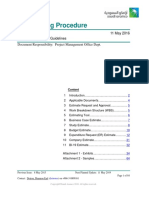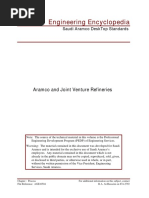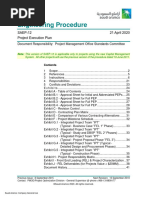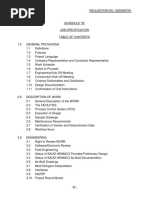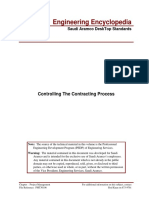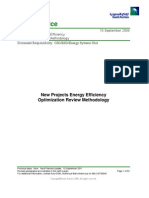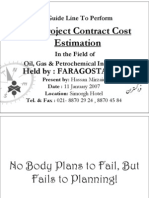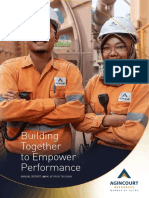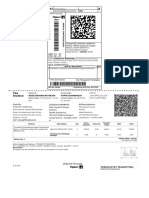PMT 10306
PMT 10306
Uploaded by
Yousef Adel HassanenCopyright:
Available Formats
PMT 10306
PMT 10306
Uploaded by
Yousef Adel HassanenOriginal Title
Copyright
Available Formats
Share this document
Did you find this document useful?
Is this content inappropriate?
Copyright:
Available Formats
PMT 10306
PMT 10306
Uploaded by
Yousef Adel HassanenCopyright:
Available Formats
Engineering Encyclopedia
Saudi Aramco DeskTop Standards
Project Closeout And Final Cost Reporting
Note: The source of the technical material in this volume is the Professional
Engineering Development Program (PEDP) of Engineering Services.
Warning: The material contained in this document was developed for Saudi
Aramco and is intended for the exclusive use of Saudi Aramco’s employees.
Any material contained in this document which is not already in the public
domain may not be copied, reproduced, sold, given, or disclosed to third
parties, or otherwise used in whole, or in part, without the written permission
of the Vice President, Engineering Services, Saudi Aramco.
Chapter : Project Management For additional information on this subject, contact
File Reference: PMT10306 J. McKissak
Engineering Encyclopedia Project Management
Project Closeout And Final Cost Reporting
Contents Pages
INTRODUCTION................................................................................................................ 1
Project Closeout........................................................................................................ 1
Project Acceptance.................................................................................................... 1
Service Date and ERC Date....................................................................................... 1
Contract Closeout ..................................................................................................... 2
Financial Closeout ..................................................................................................... 2
SP Account Set Up and Closing ................................................................................ 2
SP Account Set Up and Closing ................................................................................ 3
Other Closeout Considerations .................................................................................. 4
FINAL PROJECT COST REPORT...................................................................................... 5
Content of the Final Cost Report ............................................................................... 5
Documents to be Included ......................................................................................... 5
Engineering Details ................................................................................................... 6
Out-of-Kingdom Engineering .................................................................................... 6
In-Kingdom Engineering ........................................................................................... 6
Material Details ......................................................................................................... 6
Construction Details.................................................................................................. 7
GLOSSARY......................................................................................................................... 8
Saudi Aramco DeskTop Standards
Engineering Encyclopedia Project Management
Project Closeout And Final Cost Reporting
INTRODUCTION
This module introduces the Participant to the closeout process, which is used at Saudi Aramco to
ensure that all known costs are included in the final cost of capital projects. This module also
introduces the Participant to the preparation of the final project cost report, which is used at
Saudi Aramco to gather and preserve historical cost information. To accomplish these objectives,
we will discuss the applicable Company methods, procedures and guidelines.
Project Closeout
When a capital project is deemed mechanically complete, the SAPMT begins the closeout
activities. When closeout starts, many of the members of the project management team have been
moved to other projects. It has been determined that few uncompleted physical tasks remain for
the contractor to finish. The remaining activities constitute the collection of outstanding costs,
setting up a special project (SP) account, and the closing all accounts in the financial master.
Project Acceptance
After mechanical completion, an acceptance committee prepares a Mechanical Completion
Certificate (MCC). The MCC signifies that the project is ready for commissioning and startup.
Commissioning is the process of testing each portion of the facility to ensure that safety tolerances
are met, equipment operates according to vendor warranties, and all operating manuals and
operator training is completed. Startup is the process of placing the facility or process in operation
and producing the product at the rate that is specified in the design basis scoping paper.
After approval of the mechanical completion certificate, no other charges are initiated against the
budget item or job order except costs that are associated with commissioning and startup
activities.
A partial mechanical completion certificate may be submitted for a portion of a facility that can be
treated as a separate entity. That condition usually arises when management desires an early
onstream date for one or more processes in a facility.
Startup and commissioning activities are followed by an operating shakedown period to
demonstrate the project's performance. Once the project meets performance specifications, a
Performance Acceptance Certificate is issued. The performance acceptance certificate signifies
that the project is accepted by the operating proponent for commercial operation, even though
minor exceptions items may be outstanding.
Service Date and ERC Date
The service date on the mechanical completion certificate indicates when the facility is ready for
startup. For financial accounting purposes, the service date is the date when plant depreciation
starts.
The ER Completion (ERC) date is coincidental with the date that the performance acceptance
certificate is signed. Both the mechanical completion certificate and the performance acceptance
certificate dates are construction milestones and are not directly related to project financial close-
out.
Saudi Aramco DeskTop Standards 1
Engineering Encyclopedia Project Management
Project Closeout And Final Cost Reporting
Contract Closeout
While closely integrated with the project financial closeout activities, contract closeout efforts are
viewed independently. The SAPMT cost engineer works closely with the Contracting Department
and the representative whom the department has assigned to the project. From a contracting point
of view, a contract is closed out as soon as possible after the obligations of the parties to the
contract have been fulfilled. The contract closeout procedure is designed to release Saudi Aramco
from further obligations wherever possible and to ensure against further payments under the
contract.
There are two alternative methods of closing out a contract. The first method uses the Final
Release Agreement. The second method uses the Contract Closeout Document with a final
release agreement. All documents are initiated and signed by the contract proponent and signed by
the contractor.
Financial Closeout
To initiate financial closeout, the mechanical completion certificate must be approved and
submitted to the Fixed Assets and Work-in-Progress Accounting Department (FA&WIPAD). The
performance acceptance certificate does not need to be approved prior to starting the financial
closeout activities. Financial closeout should not be unreasonably delayed for projects that are
essentially complete and against which all major elements of cost have been recorded.
Accordingly, FA&WIPAD may open a special project account for financial closeout or
outstanding change orders and contract payments that can be reasonably estimated.
SP Account Set Up and Closing
If the estimated cost of completion does not exceed five percent of the approved ER funds, a
special project account may be established. The estimated remaining costs are charged to a job
order within the ER and credited to the special project account. The estimated costs are identified
on the Special Project Account - Cost Estimate form, which provides separate columns for the
major cost elements of engineering, materials and construction. The SAPMT may subdivide these
columns into cost categories and provide cost estimates accordingly. Similarly, when the SAPMT
requires specific entry codes and phases to be charged, the SAPMT must indicate these
requirements in the provided columns. Figure 1 shows the Special Project Account - Cost
Estimate form.
Saudi Aramco DeskTop Standards 2
Engineering Encyclopedia Project Management
Project Closeout And Final Cost Reporting
Figure 1 Special Project Account - Cost Estimate Form
SP Account Set Up and Closing
The Special Project Account - Cost Estimate form is transmitted to FA&WIPAD with a cover
letter from the SAPMT that includes:
Saudi Aramco DeskTop Standards 3
Engineering Encyclopedia Project Management
Project Closeout And Final Cost Reporting
• Reference to the JO(s) to be charged or credited with the estimate.
• The estimated completion date of the activity that is covered by the special project
account.
• A brief comment that explains the need for a special project account. Examples would
be: a late charge, surplus material problem, or exception item construction work.
• A brief comment on exception item construction work that results in a separately
identifiable equipment unit. In this case, a general list of major materials with the
estimated costs is included in order for the job accountant to properly record assets in
the company records and to identify any major material coding problems.
• An identification of any work that will be performed by the project proponent and
charged to the special project account.
• Upon receipt of the special project account - cost estimate and cover letter,
FA&WIPAD reviews the request and ensures that:
• All major project facilities are mechanically complete, with approved mechanical
completion certificate(s) on file.
• The intent of the special project is not to build a major facility or to perform work
outside the approved project scope.
• The special project account - cost estimate does not exceed five percent of the
approved ER amount, and this estimate incudes any previously opened special project
accounts for the same ER.
SAPMTs are responsible for monitoring and controlling their special project accounts until
formally closed by FA&WIPAD. The SAPMT must write an extension letter to FA&WIPAD to
explain any need to extend the completion date of the special project account.
Other Closeout Considerations
SAPMTs must ensure that all outstanding material commitments are resolved as early as possible
prior to financial closeout. With DC material, early consideration is given to the declaration of
surplus material, transfers to other jobs and transfers to reclamation. With SAMS material, early
attention is directed to the cancellation of open material allocations, returns to stock, transfers to
other jobs, and transfers to reclamation. All SCECO connection fees must be recorded or an
estimated cost that is included for each JO prior to closure.
Saudi Aramco DeskTop Standards 4
Engineering Encyclopedia Project Management
Project Closeout And Final Cost Reporting
FINAL PROJECT COST REPORT
The final project cost report provides an historical record of the actual cost of a project. related
schedule, contract, and other project planning and control information. The information that is
taken from the report is used to update various data bases that are used for cost estimating and
schedule forecasting purposes. The information is also used to revise associated procedures and
methods that could assist project management in maintaining better project controls.
A final project cost report is prepared by the SAPMT for those projects that have an ER value
that exceeds $20 million. An abbreviated final project cost report is optional for projects of less
than $20 million.
Assistance to the SAPMT is available from the Project Controls Division, Project Support &
Controls Department. The Project Controls Division maintains copies of the budget brief, AFEs,
change orders, all monthly project status reports, the various cost estimates, and the project
completion schedules. These documents are the source of much of the information that is required
to complete the final project cost report.
Upon completion of the project proposal engineering effort, the first section of the final project
cost report is submitted. The first section of the final project cost report is intended to collect and
report data on expenditures that were incurred under type code 68 funding. Submission of the
first section of the final cost report also provides initial information several years earlier than
would be provided if only a final report is submitted at project completion.
The final project cost report is submitted within three months of the final Monthly Project Update
report. The information that is contained in the interim report, if prepared, does not need to be
repeated.
A copy of the final project cost report is kept by the project department, and the original report is
sent to the Project Controls Division of Project Support & Controls Department.
Content of the Final Cost Report
The format of the final project cost report is found in Saudi Aramco Engineering Procedure
(SAEP) 23, which is shown in the Addendum.
Documents to be Included
As a minimum, the final project cost report should include the following:
• A copy of the final Project Planning Update Report (PPU), Monthly Project
Update Report (MPU), Project Completion Schedule (PCS), Proposal
Engineering Statistics Report (PES) and/or Design Engineering Statistics
(DES), and the final UI04 microfiche.
Saudi Aramco DeskTop Standards 5
Engineering Encyclopedia Project Management
Project Closeout And Final Cost Reporting
• A completed Project Cost Information Report that follows the applicable
formats as found in SAEP-23.
• Manpower charts and/or manhour curves for the design and construction
contractors, Saudi Aramco Project Team, and Program Management
Contractor.
• Quarterly Review Packages that were presented during the project duration.
• Identification of any major situations that affected the project's expenditures or
schedules.
• The ER Budget Estimate Brief and other significant estimate briefs such as any
check estimate, contract estimate and change order estimate that were
prepared by the Project Support & Controls Department.
• A copy of the Change Order Log and Project Change Requests for the ER.
Engineering Details
Engineering is divided between project proposal and detail design. The purpose of separately
collecting information on project proposal engineering is to permit the submission of a partial cost
report.
Out-of-Kingdom Engineering
Expenses that are incurred by the SAPMT, out-of-Kingdom, will include average yearly cost per
man. Also shown are such miscellaneous costs as office rental and business trip expenses. In
addition to cost information, the number of man-hours per activity is required.
Contractor engineering requires the separation of drawings from other activities with the man-
hours and total dollars for each drawing. Also, the average man-hours per drawing is to be
provided. Schedule dates for award and completion of both proposal and design are to be
provided.
In-Kingdom Engineering
In-Kingdom engineering details are the same as for out-of-Kingdom engineering details, except
that information on soil and laboratory testing, vehicle usage and surveying is added.
Material Details
Major items of direct charge material, by phase number, are to be furnished with the purchase
order number, description, purchase order value, LDF cost, and total cost.
Saudi Aramco DeskTop Standards 6
Engineering Encyclopedia Project Management
Project Closeout And Final Cost Reporting
Construction Details
Contractor construction information includes awarded contracts, type of contract, construction
startup date, construction completion date, and contract completion date. The base contract
details include LSTK engineering, construction, contractor provided construction equipment . and
contractor-provided materials. The number of contract amendments, change order and claims are
to be shown both as to the number of transactions and the total dollars for each category. Unit
rates are also to be included.
The SAPMT man-hours and total dollars are to be provided. Also, the same information is
required for supporting organizations such as the in-Kingdom program management contractor
activity. Inspection, pre-commissioning, and startup activities are to be reflected in both man-
hours and total dollars. The special project account funding (TC67) is to be shown as a total.
SAEP-23, Final Project Cost Report, is included as an addendum to this module.
Saudi Aramco DeskTop Standards 7
Engineering Encyclopedia Project Management
Project Closeout And Final Cost Reporting
GLOSSARY
Closeout The activities that constitute finalization and closing of the
project accounts before the SAPMT is disbanded and it's
members are assigned to other projects.
Exception Item A minor amount of mechanical work that remains near the
completion of a capital project. The exception item does
not affect startup or commissioning of the project.
Final Project The final project cost report provides a record of a
project's actual costs with related information on schedule,
Cost Report contracting and other project planning and control
activities.
Mechanical Mechanical completion indicates that the project is ready
for startup and commissioning. It is also a milestone on
Completion the project completion schedule.
Mechanical The mechanical completion certificate certifies that the
project is ready for startup and commissioning.
Completion Certificate
Partial If a divisible portion of a facility is deemed mechanically
complete for startup and commissioning, that portion may
Mechanical Completion be covered by a partial mechanical completion certificate.
Performance Acceptance The performance acceptance certificate is a document that
is submitted to FA&WIPAD and that has been signed by
Certificate representatives of the construction agency, maintenance,
operations engineering and the proponent performance
acceptance certificate organization. The certifies
compliance with all specifications and it certifies that the
facility meets all operating requirements.
Quarterly A presentation that is conducted by the SAPMT and
contractor(s) for the benefit of E&PM management. The
Review purpose of the quarterly review is the regular review of
major projects with emphasis on problem areas and
deviations from schedule or forecast.
Service Date The calendar date that is indicated on the mechanical
completion certificate when a facility is ready for startup
and commissioning.
Saudi Aramco DeskTop Standards 8
Engineering Encyclopedia Project Management
Project Closeout And Final Cost Reporting
Special Project Funds that are set up for the completion of the final 5% or
less of a project and in an amount not exceeding $5
Account million. Special project funds are also known at type code
67 (TC-67).
Startup Following mechanical completion of a facility, the
activities that prepare that facility to commence
commissioning and subsequent production.
Surplus Material Direct charge material that was purchased but not required
for a capital project. This material must be declared as
surplus to the project, and it must be transferred to the
surplus material yard for partial credit.
Saudi Aramco DeskTop Standards 9
You might also like
- SAEP-331Document1 pageSAEP-331nasserraheem99No ratings yet
- Planning and Scheduling During Detailed EngineeringDocument34 pagesPlanning and Scheduling During Detailed EngineeringHedi Zarkouna91% (23)
- Saep 329Document20 pagesSaep 329Reda ElsayedNo ratings yet
- Saep 25 PDFDocument84 pagesSaep 25 PDFBIPIN BALANNo ratings yet
- Saep 38Document23 pagesSaep 38Syed ImranNo ratings yet
- Project Controls in A Capital Project EnvironmentDocument30 pagesProject Controls in A Capital Project EnvironmentAbdulaziz Ibrahim100% (1)
- PMT 30104Document22 pagesPMT 30104Yousef Adel HassanenNo ratings yet
- 203-04a - PROJECT COST CONTROL AND PLANNINGDocument12 pages203-04a - PROJECT COST CONTROL AND PLANNINGYusufNo ratings yet
- PMT 10505Document27 pagesPMT 10505cvg ertdNo ratings yet
- Overview of EstimatingDocument59 pagesOverview of EstimatingChu le Van100% (4)
- Saep 26Document30 pagesSaep 26brecht1980No ratings yet
- Saep 60 PDFDocument19 pagesSaep 60 PDFRami Elloumi100% (1)
- OPOIDocument56 pagesOPOIBIPIN BALANNo ratings yet
- Saep 74Document29 pagesSaep 74munna100% (2)
- RefineriesDocument54 pagesRefineriesمحمد خ.ل50% (2)
- 2014 03 Earned Value Management Brown BagDocument39 pages2014 03 Earned Value Management Brown BagSean Keats100% (2)
- Construction Project Brief Template4Document14 pagesConstruction Project Brief Template4Chan Siew Chong0% (2)
- Exam Technique For Advanced Audit and AssuranceDocument5 pagesExam Technique For Advanced Audit and AssurancebunipatNo ratings yet
- PMT 10302Document21 pagesPMT 10302Yousef Adel HassanenNo ratings yet
- PMT 10305Document30 pagesPMT 10305Yousef Adel HassanenNo ratings yet
- PMT 30101Document37 pagesPMT 30101Yousef Adel HassanenNo ratings yet
- PMT 30103Document41 pagesPMT 30103Yousef Adel HassanenNo ratings yet
- PMT 20108Document52 pagesPMT 20108Yousef Adel HassanenNo ratings yet
- PMT 10507Document21 pagesPMT 10507cvg ertdNo ratings yet
- PMT 10303Document17 pagesPMT 10303Yousef Adel HassanenNo ratings yet
- Saep 51Document39 pagesSaep 51Anonymous 4IpmN7OnNo ratings yet
- PMT 10304Document17 pagesPMT 10304Yousef Adel HassanenNo ratings yet
- Development of The Project ProposalDocument40 pagesDevelopment of The Project Proposalnotruwan100% (3)
- PMT 10301Document23 pagesPMT 10301Yousef Adel Hassanen100% (1)
- Saep 140 PDFDocument28 pagesSaep 140 PDFAdnanAtifNo ratings yet
- Saep 72 PDFDocument11 pagesSaep 72 PDFRami ElloumiNo ratings yet
- PMT 10106Document5 pagesPMT 10106Yousef Adel HassanenNo ratings yet
- PMT 30105Document29 pagesPMT 30105Yousef Adel HassanenNo ratings yet
- PMT 30108Document30 pagesPMT 30108Yousef Adel HassanenNo ratings yet
- PMT 10105Document7 pagesPMT 10105Yousef Adel HassanenNo ratings yet
- Saep 12Document41 pagesSaep 12Syed ImranNo ratings yet
- Saep 74Document36 pagesSaep 74Salvatore Masala100% (1)
- PMT 10103Document9 pagesPMT 10103cvg ertdNo ratings yet
- C4 General PDFDocument62 pagesC4 General PDFNadim JilaniNo ratings yet
- SAEP-331 SA Scheduling RequirementsDocument1 pageSAEP-331 SA Scheduling Requirementsnasserraheem990% (1)
- Saep 26 PDFDocument31 pagesSaep 26 PDFSalik SiddiquiNo ratings yet
- Schedule B PDFDocument122 pagesSchedule B PDFHarun RashidNo ratings yet
- PMT 30106Document36 pagesPMT 30106Yousef Adel HassanenNo ratings yet
- Saep 26Document14 pagesSaep 26nadeem shaikhNo ratings yet
- Saep 201Document5 pagesSaep 201brecht1980No ratings yet
- Project Management Manual (PMM) - 02Document751 pagesProject Management Manual (PMM) - 02Mohamed Abdella100% (1)
- Sabp A 012Document92 pagesSabp A 012sethu1091No ratings yet
- Saep 42 PDFDocument11 pagesSaep 42 PDFRami ElloumiNo ratings yet
- STOD OTP PMT 0808 PM PRO 0001 Progress Measurement ProcedureDocument21 pagesSTOD OTP PMT 0808 PM PRO 0001 Progress Measurement Procedurejfl2096No ratings yet
- A Guide Line To Perform: EPC Project Contract Cost EstimationDocument60 pagesA Guide Line To Perform: EPC Project Contract Cost EstimationieltsabadanNo ratings yet
- Detailed Process of Project Execution & Progress Measurement and TrackingDocument22 pagesDetailed Process of Project Execution & Progress Measurement and Trackingzhangj5100% (1)
- Mex 30204Document26 pagesMex 30204Yousef Adel HassanenNo ratings yet
- Saep 20 PDFDocument25 pagesSaep 20 PDFbrecht1980100% (1)
- Guide 05c - C and P Tactics DevelopmentDocument25 pagesGuide 05c - C and P Tactics Developmentodunze1100% (1)
- Oil and Gas Major Projects Development and Execution FlowchartDocument1 pageOil and Gas Major Projects Development and Execution FlowchartCapitalprojects ConsultingNo ratings yet
- SAEP-14 Project ProposalDocument53 pagesSAEP-14 Project ProposalRaad Abwini100% (1)
- The Critical Path of and Oil and Gas ProjectDocument3 pagesThe Critical Path of and Oil and Gas ProjectHervéNo ratings yet
- Saep 1350Document51 pagesSaep 1350nadeem shaikh100% (2)
- 3.6 A. Schedule Control ProcedureDocument6 pages3.6 A. Schedule Control ProcedureChiamaka ObadiegwuNo ratings yet
- CMS PQPDocument45 pagesCMS PQPahmsami91No ratings yet
- SAEP-14Document41 pagesSAEP-14Muzammil AlbadriNo ratings yet
- PT Sev - Ye Ii Deneme Test - NG - L - ZceDocument10 pagesPT Sev - Ye Ii Deneme Test - NG - L - ZceYousef Adel HassanenNo ratings yet
- M/s. Smart Technocrats & Consultancy Services (I) PVT. LTDDocument7 pagesM/s. Smart Technocrats & Consultancy Services (I) PVT. LTDYousef Adel HassanenNo ratings yet
- PT Level 2Document26 pagesPT Level 2Yousef Adel HassanenNo ratings yet
- PT Exam 2Document13 pagesPT Exam 2Yousef Adel HassanenNo ratings yet
- PT General 2Document4 pagesPT General 2Yousef Adel HassanenNo ratings yet
- Mex 10407Document28 pagesMex 10407Yousef Adel HassanenNo ratings yet
- Mex 10406Document53 pagesMex 10406Yousef Adel HassanenNo ratings yet
- Bank Nifty Scalping StrategyDocument4 pagesBank Nifty Scalping StrategyEsramrajuNo ratings yet
- 5 Forces Acecook: 1. Potential Competition (Aka. Threat of New Entrants)Document2 pages5 Forces Acecook: 1. Potential Competition (Aka. Threat of New Entrants)Pham Thi Yen Linh (BTEC HN)No ratings yet
- Chapter 03Document32 pagesChapter 03moein imaniNo ratings yet
- White Paper 3 Ways Recognition Combats Economic UncertaintyDocument14 pagesWhite Paper 3 Ways Recognition Combats Economic UncertaintySushil RautNo ratings yet
- Track Shipment Status - Consignment Status - DTDC IndiaDocument1 pageTrack Shipment Status - Consignment Status - DTDC IndiaAshvanee Kr. PathakNo ratings yet
- ICICI Bank Launches ICICI STACK For Corporates To Offer Ecosystem BankingDocument3 pagesICICI Bank Launches ICICI STACK For Corporates To Offer Ecosystem BankingRam CharanNo ratings yet
- Heavy Duty Jaw & Cone Crusher Liner OptionsDocument3 pagesHeavy Duty Jaw & Cone Crusher Liner OptionsAndrey L'vov100% (1)
- Hydro Forming Seminar ReportDocument17 pagesHydro Forming Seminar ReportBalu PrasannanNo ratings yet
- Marketing Colour Psychology and Its Relevance in Computer ScienceDocument13 pagesMarketing Colour Psychology and Its Relevance in Computer ScienceHrishitva PatelNo ratings yet
- Internal Control & Internal Check-1Document2 pagesInternal Control & Internal Check-1naxahejNo ratings yet
- BÀI TIẾNG ANHDocument49 pagesBÀI TIẾNG ANHThịnh Nguyễn QuốcNo ratings yet
- MailerLite Email Marketing Calendar TemplateDocument15 pagesMailerLite Email Marketing Calendar TemplatewriteanythingngNo ratings yet
- Gregory 2020Document41 pagesGregory 2020donluciano6969No ratings yet
- JYP GLOBAL AUDITION GENERAL RELEASE (Minor)Document3 pagesJYP GLOBAL AUDITION GENERAL RELEASE (Minor)Gaby AvilaNo ratings yet
- Your Account Details Segment'S RegisteredDocument2 pagesYour Account Details Segment'S Registeredlotuslama07No ratings yet
- Assignment On Tourism MarketingDocument24 pagesAssignment On Tourism MarketingVipin AshokNo ratings yet
- Parsing SWIFTDocument7 pagesParsing SWIFTAmarGokNo ratings yet
- Agincourt Resources Annual Report 2019 PDFDocument169 pagesAgincourt Resources Annual Report 2019 PDFMinar GraceNo ratings yet
- Iso 23233 2009 en FR PDFDocument6 pagesIso 23233 2009 en FR PDFergtewfgergNo ratings yet
- Easy 12minuteaffiliate Com JVDocument7 pagesEasy 12minuteaffiliate Com JVVikram kumarNo ratings yet
- Activity 1 - Distribution ManagementDocument2 pagesActivity 1 - Distribution Managementbeverly managaytayNo ratings yet
- Software Development Lifecycle Models PDFDocument6 pagesSoftware Development Lifecycle Models PDFTOP MOVIESNo ratings yet
- Saving and InvestmentDocument96 pagesSaving and Investmentsanusahad123No ratings yet
- Flipkart Labels 01 Jul 2024-10-12Document14 pagesFlipkart Labels 01 Jul 2024-10-12trendofistmarketingNo ratings yet
- Taxation Sec B May 2024 1703584298Document6 pagesTaxation Sec B May 2024 1703584298abhishekkapse654No ratings yet
- Economics Project: Professor Dharmendra United World School of Law (UWSL), Karnavati University (Faculty-Economics)Document37 pagesEconomics Project: Professor Dharmendra United World School of Law (UWSL), Karnavati University (Faculty-Economics)ytrdfghjjhgfdxcfghNo ratings yet
- Business Strategy of VinamilkDocument31 pagesBusiness Strategy of VinamilkNgọc KhánhNo ratings yet
- PDF FanucDocument28 pagesPDF Fanucheart princeNo ratings yet
- India Elevator Market - Analysis and Forecast (2024-2030)Document9 pagesIndia Elevator Market - Analysis and Forecast (2024-2030)infoNo ratings yet



